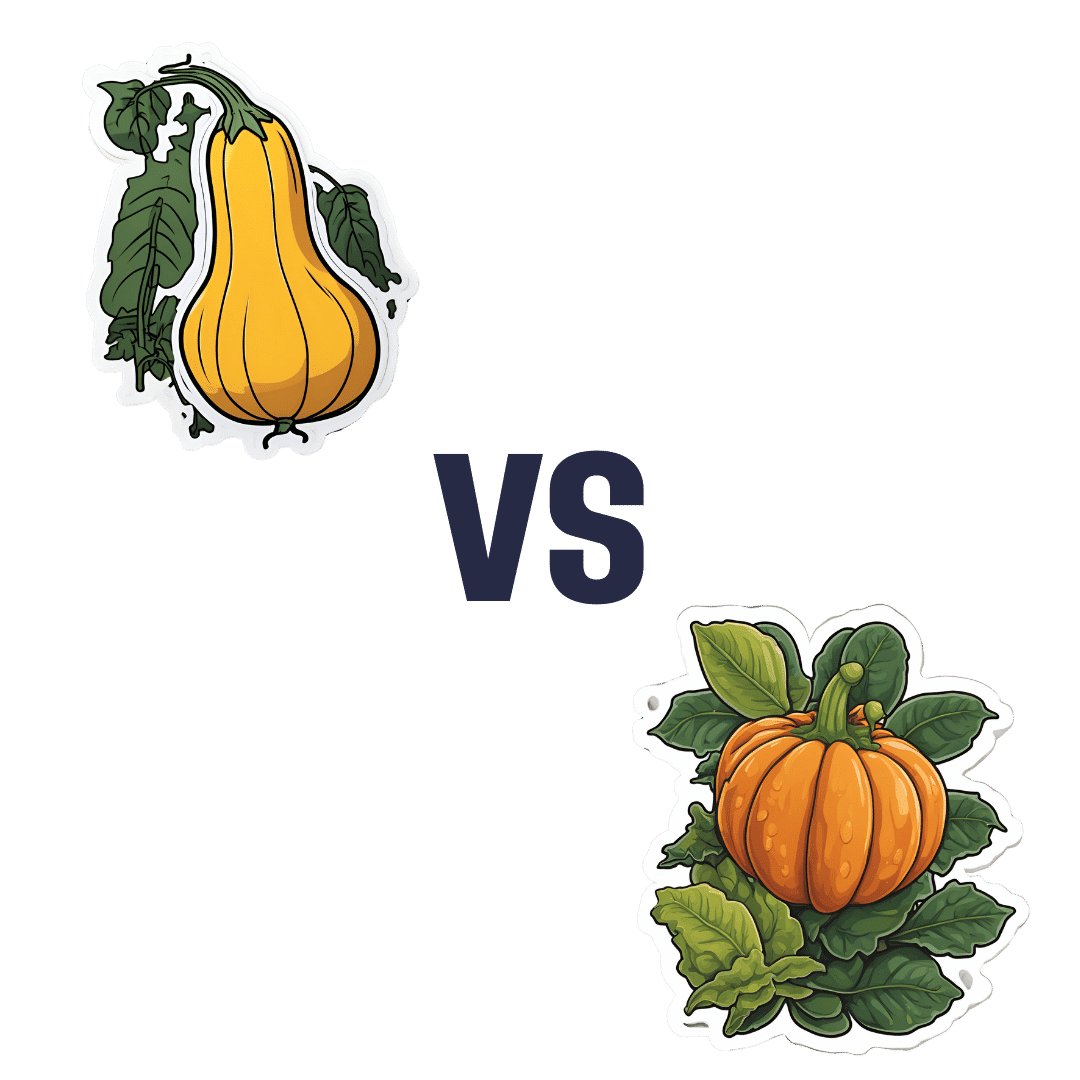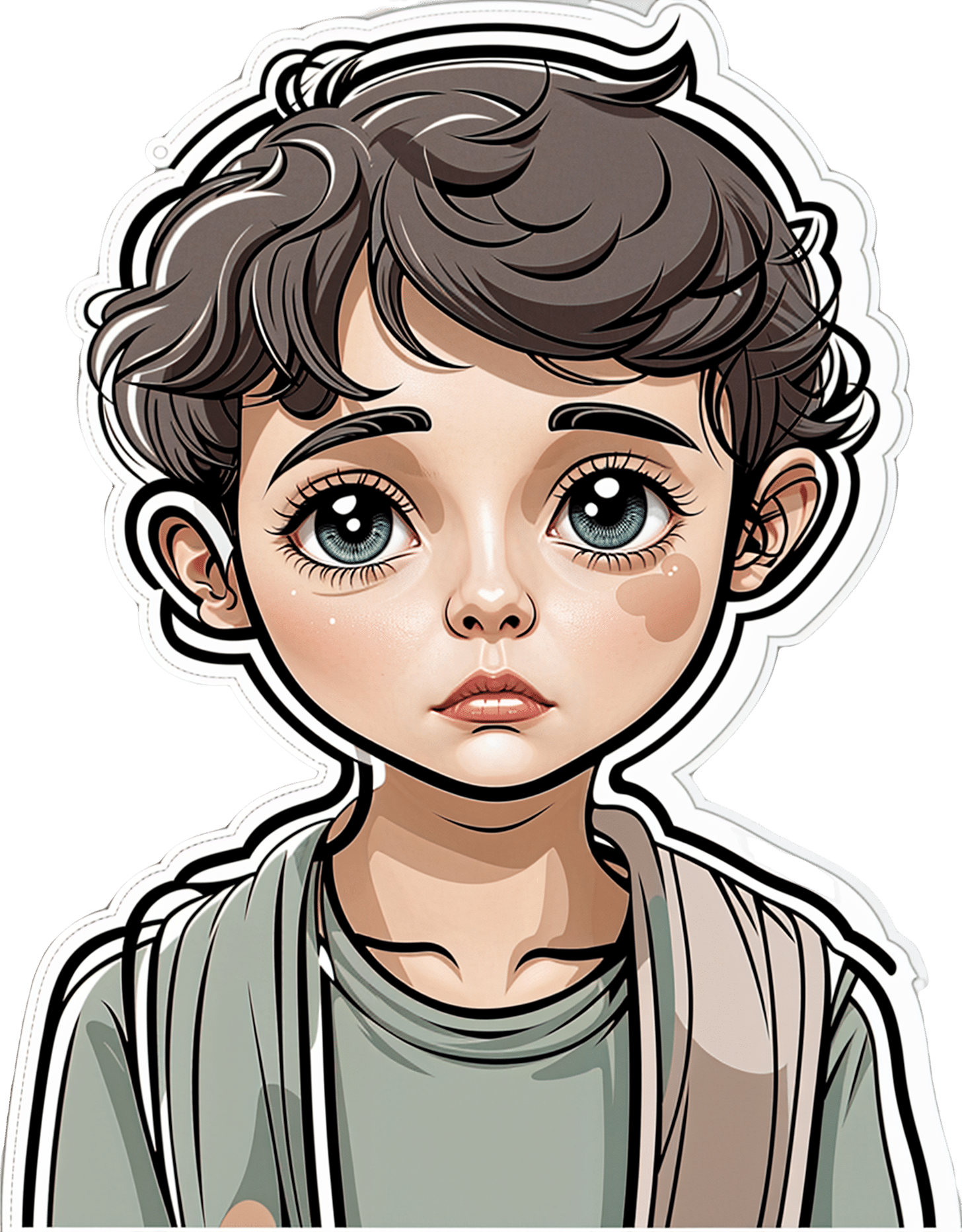
Butternut Squash vs Pumpkin – Which is Healthier?
10almonds is reader-supported. We may, at no cost to you, receive a portion of sales if you purchase a product through a link in this article.
Our Verdict
When comparing butternut squash to pumpkin, we picked the butternut squash.
Why?
Both are great! But the butternut squash manages a moderate win in most categories.
In terms of macros, butternut squash has more of everything except water. Most notably, it has more protein and more fiber. Yes, more carbs too, but the fiber content means that it also has the lower glycemic index, by quite a bit.
When it comes to vitamins, pumpkin does have a little more of vitamin B1 and a lot more of vitamin E, while butternut squash has more of vitamins B3, B5, B9, C, K, and choline. They’re about equal in the other vitamins they both contain. A fair win for butternut squash.
In the category of minerals, butternut squash has more calcium, magnesium, manganese, and selenium, while pumpkin has more copper, iron, and phosphorus. They’re about equal in potassium and zinc. A marginal win for butternut squash.
Adding up the strong win, the fair win, and the marginal win, makes for an easy overall win for butternut squash!
Want to learn more?
You might like to read:
Superfood-Stuffed Squash Recipe
Take care!
Don’t Forget…
Did you arrive here from our newsletter? Don’t forget to return to the email to continue learning!
Recommended
Learn to Age Gracefully
Join the 98k+ American women taking control of their health & aging with our 100% free (and fun!) daily emails:
-
Parents are increasingly saying their child is ‘dysregulated’. What does that actually mean?
10almonds is reader-supported. We may, at no cost to you, receive a portion of sales if you purchase a product through a link in this article.
Welcome aboard the roller coaster of parenthood, where emotions run wild, tantrums reign supreme and love flows deep.
As children reach toddlerhood and beyond, parents adapt to manage their child’s big emotions and meltdowns. Parenting terminology has adapted too, with more parents describing their child as “dysregulated”.
But what does this actually mean?
ShUStudio/Shutterstock More than an emotion
Emotional dysregulation refers to challenges a child faces in recognising and expressing emotions, and managing emotional reactions in social settings.
This may involve either suppressing emotions or displaying exaggerated and intense emotional responses that get in the way of the child doing what they want or need to do.
“Dysregulation” is more than just feeling an emotion. An emotion is a signal, or cue, that can give us important insights to ourselves and our preferences, desires and goals.
An emotionally dysregulated brain is overwhelmed and overloaded (often, with distressing emotions like frustration, disappointment and fear) and is ready to fight, flight or freeze.
Developing emotional regulation
Emotion regulation is a skill that develops across childhood and is influenced by factors such as the child’s temperament and the emotional environment in which they are raised.
In the stage of emotional development where emotion regulation is a primary goal (around 3–5 years old), children begin exploring their surroundings and asserting their desires more actively.
A child’s temperament and upbringing affect how they regulate emotions. bluedog studio/Shutterstock It’s typical for them to experience emotional dysregulation when their initiatives are thwarted or criticised, leading to occasional tantrums or outbursts.
A typically developing child will see these types of outbursts reduce as their cognitive abilities become more sophisticated, usually around the age they start school.
Express, don’t suppress
Expressing emotions in childhood is crucial for social and emotional development. It involves the ability to convey feelings verbally and through facial expressions and body language.
When children struggle with emotional expression, it can manifest in various ways, such as difficulty in being understood, flat facial expressions even in emotionally charged situations, challenges in forming close relationships, and indecisiveness.
Several factors, including anxiety, attention-deficit hyperactivity disorder (ADHD), autism, giftedness, rigidity and both mild and significant trauma experiences, can contribute to these issues.
Common mistakes parents can make is dismissing emotions, or distracting children away from how they feel.
These strategies don’t work and increase feelings of overwhelm. In the long term, they fail to equip children with the skills to identify, express and communicate their emotions, making them vulnerable to future emotional difficulties.
We need to help children move compassionately towards their difficulties, rather than away from them. Parents need to do this for themselves too.
Caregiving and skill modelling
Parents are responsible for creating an emotional climate that facilitates the development of emotion regulation skills.
Parents’ own modelling of emotion regulation when they feel distressed. The way they respond to the expression of emotions in their children, contributes to how children understand and regulate their own emotions.
Children are hardwired to be attuned to their caregivers’ emotions, moods, and coping as this is integral to their survival. In fact, their biggest threat to a child is their caregiver not being OK.
Unsafe, unpredictable, or chaotic home environments rarely give children exposure to healthy emotion expression and regulation. Children who go through maltreatment have a harder time controlling their emotions, needing more brainpower for tasks that involve managing feelings. This struggle could lead to more problems with emotions later on, like feeling anxious and hypervigilant to potential threats.
Recognising and addressing these challenges early on is essential for supporting children’s emotional wellbeing and development.
A dysregulated brain and body
When kids enter “fight or flight” mode, they often struggle to cope or listen to reason. When children experience acute stress, they may respond instinctively without pausing to consider strategies or logic.
If your child is in fight mode, you might observe behaviours such as crying , clenching fists or jaw, kicking, punching, biting, swearing, spitting or screaming.
In flight mode, they may appear restless, have darting eyes, exhibit excessive fidgeting, breathe rapidly, or try to run away.
A shut-down response may look like fainting or a panic attack.
When a child feels threatened, their brain’s frontal lobe, responsible for rational thinking and problem-solving, essentially goes offline.
The amygdala, shown here in red, triggers survival mode. pikovit/Shutterstock This happens when the amygdala, the brain’s alarm system, sends out a false alarm, triggering the survival instinct.
In this state, a child may not be able to access higher functions like reasoning or decision-making.
While our instinct might be to immediately fix the problem, staying present with our child during these moments is more effective. It’s about providing support and understanding until they feel safe enough to engage their higher brain functions again.
Reframe your thinking so you see your child as having a problem – not being the problem.
Tips for parents
Take turns discussing the highs and lows of the day at meal times. This is a chance for you to be curious, acknowledge and label feelings, and model that you, too, experience a range of emotions that require you to put into practice skills to cope and has shown evidence in numerous physical, social-emotional, academic and behavioural benefits.
Talk about your day over dinner. Monkey Business Images/Shutterstock Spending even small amounts (five minutes a day!) of quality one-on-one time with your child is an investment in your child’s emotional wellbeing. Let them pick the activity, do your best to follow their lead, and try to notice and comment on the things they do well, like creative ideas, persevering when things are difficult, and being gentle or kind.
Take a tip from parents of children with neurodiversity: learn about your unique child. Approaching your child’s emotions, temperament, and behaviours with curiosity can help you to help them develop emotion regulation skills.
When to get help
If emotion dysregulation is a persistent issue that is getting in the way of your child feeling happy, calm, or confident – or interfering with learning or important relationships with family members or peers – talk to their GP about engaging with a mental health professional.
Many families have found parenting programs helpful in creating a climate where emotions can be safely expressed and shared.
Remember, you can’t pour from an empty cup. Parenting requires you to be your best self and tend to your needs first to see your child flourish.
Cher McGillivray, Assistant Professor Psychology Department, Bond University and Shawna Mastro Campbell, Assistant Professor Psychology, Bond University
This article is republished from The Conversation under a Creative Commons license. Read the original article.
Share This Post
-
How we diagnose and define obesity is set to change – here’s why, and what it means for treatment
10almonds is reader-supported. We may, at no cost to you, receive a portion of sales if you purchase a product through a link in this article.
Obesity is linked to many common diseases, such as type 2 diabetes, heart disease, fatty liver disease and knee osteoarthritis.
Obesity is currently defined using a person’s body mass index, or BMI. This is calculated as weight (in kilograms) divided by the square of height (in metres). In people of European descent, the BMI for obesity is 30 kg/m² and over.
But the risk to health and wellbeing is not determined by weight – and therefore BMI – alone. We’ve been part of a global collaboration that has spent the past two years discussing how this should change. Today we publish how we think obesity should be defined and why.
As we outline in The Lancet, having a larger body shouldn’t mean you’re diagnosed with “clinical obesity”. Such a diagnosis should depend on the level and location of body fat – and whether there are associated health problems.
World Obesity Federation What’s wrong with BMI?
The risk of ill health depends on the relative percentage of fat, bone and muscle making up a person’s body weight, as well as where the fat is distributed.
Athletes with a relatively high muscle mass, for example, may have a higher BMI. Even when that athlete has a BMI over 30 kg/m², their higher weight is due to excess muscle rather than excess fatty tissue.
Some athletes have a BMI in the obesity category. Tima Miroshnichenko/Pexels People who carry their excess fatty tissue around their waist are at greatest risk of the health problems associated with obesity.
Fat stored deep in the abdomen and around the internal organs can release damaging molecules into the blood. These can then cause problems in other parts of the body.
But BMI alone does not tell us whether a person has health problems related to excess body fat. People with excess body fat don’t always have a BMI over 30, meaning they are not investigated for health problems associated with excess body fat. This might occur in a very tall person or in someone who tends to store body fat in the abdomen but who is of a “healthy” weight.
On the other hand, others who aren’t athletes but have excess fat may have a high BMI but no associated health problems.
BMI is therefore an imperfect tool to help us diagnose obesity.
What is the new definition?
The goal of the Lancet Diabetes & Endocrinology Commission on the Definition and Diagnosis of Clinical Obesity was to develop an approach to this definition and diagnosis. The commission, established in 2022 and led from King’s College London, has brought together 56 experts on aspects of obesity, including people with lived experience.
The commission’s definition and new diagnostic criteria shifts the focus from BMI alone. It incorporates other measurements, such as waist circumference, to confirm an excess or unhealthy distribution of body fat.
We define two categories of obesity based on objective signs and symptoms of poor health due to excess body fat.
1. Clinical obesity
A person with clinical obesity has signs and symptoms of ongoing organ dysfunction and/or difficulty with day-to-day activities of daily living (such as bathing, going to the toilet or dressing).
There are 18 diagnostic criteria for clinical obesity in adults and 13 in children and adolescents. These include:
- breathlessness caused by the effect of obesity on the lungs
- obesity-induced heart failure
- raised blood pressure
- fatty liver disease
- abnormalities in bones and joints that limit movement in children.
2. Pre-clinical obesity
A person with pre-clinical obesity has high levels of body fat that are not causing any illness.
People with pre-clinical obesity do not have any evidence of reduced tissue or organ function due to obesity and can complete day-to-day activities unhindered.
However, people with pre-clinical obesity are generally at higher risk of developing diseases such as heart disease, some cancers and type 2 diabetes.
What does this mean for obesity treatment?
Clinical obesity is a disease requiring access to effective health care.
For those with clinical obesity, the focus of health care should be on improving the health problems caused by obesity. People should be offered evidence-based treatment options after discussion with their health-care practitioner.
Treatment will include management of obesity-associated complications and may include specific obesity treatment aiming at decreasing fat mass, such as:
- support for behaviour change around diet, physical activity, sleep and screen use
- obesity-management medications to reduce appetite, lower weight and improve health outcomes such as blood glucose (sugar) and blood pressure
- metabolic bariatric surgery to treat obesity or reduce weight-related health complications.
Treatment for clinical obesity may include support for behaviour change. Shutterstock/shurkin_son Should pre-clinical obesity be treated?
For those with pre-clinical obesity, health care should be about risk-reduction and prevention of health problems related to obesity.
This may require health counselling, including support for health behaviour change, and monitoring over time.
Depending on the person’s individual risk – such as a family history of disease, level of body fat and changes over time – they may opt for one of the obesity treatments above.
Distinguishing people who don’t have illness from those who already have ongoing illness will enable personalised approaches to obesity prevention, management and treatment with more appropriate and cost-effective allocation of resources.
What happens next?
These new criteria for the diagnosis of clinical obesity will need to be adopted into national and international clinical practice guidelines and a range of obesity strategies.
Once adopted, training health professionals and health service managers, and educating the general public, will be vital.
Reframing the narrative of obesity may help eradicate misconceptions that contribute to stigma, including making false assumptions about the health status of people in larger bodies. A better understanding of the biology and health effects of obesity should also mean people in larger bodies are not blamed for their condition.
People with obesity or who have larger bodies should expect personalised, evidence-based assessments and advice, free of stigma and blame.
Louise Baur, Professor, Discipline of Child and Adolescent Health, University of Sydney; John B. Dixon, Adjunct Professor, Iverson Health Innovation Research Institute, Swinburne University of Technology; Priya Sumithran, Head of the Obesity and Metabolic Medicine Group in the Department of Surgery, School of Translational Medicine, Monash University, and Wendy A. Brown, Professor and Chair, Monash University Department of Surgery, School of Translational Medicine, Alfred Health, Monash University
This article is republished from The Conversation under a Creative Commons license. Read the original article.
Share This Post
-
ADHD medication – can you take it long term? What are the risks and do benefits continue?
10almonds is reader-supported. We may, at no cost to you, receive a portion of sales if you purchase a product through a link in this article.
Attention deficit hyperactivity disorder (ADHD) is a condition that can affect all stages of life. Medication is not the only treatment, but it is often the treatment that can make the most obvious difference to a person who has difficulties focusing attention, sitting still or not acting on impulse.
But what happens once you’ve found the medication that works for you or your child? Do you just keep taking it forever? Here’s what to consider.
What are ADHD medications?
The mainstay of medication for ADHD is stimulants. These include methylphenidate (with brand names Ritalin, Concerta) and dexamfetamine. There is also lisdexamfetamine (branded Vyvanse), a “prodrug” of dexamfetamine (it has a protein molecule attached, which is removed in the body to release dexamfetamine).
There are also non-stimulants, in particular atomoxetine and guanfacine, which are used less often but can also be highly effective. Non-stimulants can be prescribed by GPs but this may not always be covered by the Pharmaceutical Benefits Scheme and could cost more.
How stimulants work
Some stimulants prescribed for ADHD are “short acting”. This means the effect comes on after around 20 minutes and lasts around four hours.
Longer-acting stimulants give a longer-lasting effect, usually by releasing medication more slowly. The choice between the two will be guided by whether the person wants to take medication once a day or prefers to target the medication effect to specific times or tasks.
For the stimulants (with the possible exception of lisdexamfetamine) there is very little carry-over effect to the next day. This means the symptoms of ADHD may be very obvious until the first dose of the morning takes effect.
One of the main aims of treatment is the person with ADHD should live their best life and achieve their goals. In young children it is the parents who have to consider the risks and benefits on behalf of the child. As children mature, their role in decision making increases.
What about side effects?
The most consistent side effects of the stimulants are they suppress appetite, resulting in weight loss. In children this is associated with temporary slowing of the growth rate and perhaps a slight delay in pubertal development. They can also increase the heart rate and may cause a rise in blood pressure. Stimulants often cause insomnia.
These changes are largely reversible on stopping medication. However, there is concern the small rises in blood pressure could accelerate the rate of heart disease, so people who take medication over a number of years might have heart attacks or strokes slightly sooner than would have happened otherwise.
This does not mean older adults should not have their ADHD treated. Rather, they should be aware of the potential risks so they can make an informed decision. They should also make sure high blood pressure and attacks of chest pain are taken seriously.
Stimulants can be associated with stomach ache or headache. These effects may lessen over time or with a reduction in dose. While there have been reports about stimulants being misused by students, research on the risks of long-term prescription stimulant dependence is lacking.
Will medication be needed long term?
Although ADHD can affect a person’s functioning at all stages of their life, most people stop medication within the first two years.
People may stop taking it because they don’t like the way it makes them feel, or don’t like taking medication at all. Their short period on medication may have helped them develop a better understanding of themselves and how best to manage their ADHD.
In teenagers the medication may lose its effectiveness as they outgrow their dose and so they stop taking it. But this should be differentiated from tolerance, when the dose becomes less effective and there are only temporary improvements with dose increases.
Tolerance may be managed by taking short breaks from medication, switching from one stimulant to another or using a non-stimulant.
Medication is usually prescribed by a specialist but rules differ around Australia.
Ground Picture/ShutterstockToo many prescriptions?
ADHD is becoming increasingly recognised, with more people – 2–5% of adults and 5–10% of children – being diagnosed. In Australia stimulants are highly regulated and mainly prescribed by specialists (paediatricians or psychiatrists), though this differs from state to state. As case loads grow for this lifelong diagnosis, there just aren’t enough specialists to fit everyone in.
In November, a Senate inquiry report into ADHD assessment and support services highlighted the desperation experienced by people seeking treatment.
There have already been changes to the legislation in New South Wales that may lead to more GPs being able to treat ADHD. Further training could help GPs feel more confident to manage ADHD. This could be in a shared-care arrangement or independent management of ADHD by GPs like a model being piloted at Nepean Blue Mountains Local Health District, with GPs training within an ADHD clinic (where I am a specialist clinician).
Not every person with ADHD will need or want to take medication. However, it should be more easily available for those who could find it helpful.
Alison Poulton, Senior Lecturer, Brain Mind Centre Nepean, University of Sydney
This article is republished from The Conversation under a Creative Commons license. Read the original article.
Share This Post
Related Posts
-
How the stress of playing chess can be fatal
10almonds is reader-supported. We may, at no cost to you, receive a portion of sales if you purchase a product through a link in this article.
The death of a chess player in the middle of a match at the world’s most prestigious competition may have shocked those who view the game as a relaxing pastime. Kurt Meier, 67, collapsed during his final match in the tournament and died in hospital later that day. But chess, like any other game or sport, can lead to an immense amount of stress, which can be bad for a competitor’s physical health too.
We tend to associate playing sport or games with good health and well-being. And there are a countless number of studies showing playing games has an association with feeling happier. While this argument is true for recreational players, the story can be different for the elite, where success and failure are won and lost by the finest margins and where winning can mean funding and a future, and losing can mean poverty and unemployment. If this is the case, can being successful at a sport or game actually be bad for you?
Competitive anxiety
Elite competition can be stressful because the outcome is so important to the competitors. We can measure stress using a whole range of physiological indicators such as heart rate and temperature, and responses such as changes in the intensity of our emotions.
Emotions provide a warning of threat. So if you feel that achieving your goal is going to be difficult, then expect to feel intense emotions. The leading candidate that signals we are experiencing stress is anxiety, characterised by thoughts of worry, fears of dread about performance, along with accompanying physiological responses such as increased heart rate and sweaty palms. If these symptoms are experienced regularly or chronically, then this is clearly detrimental to health.
This stress response is probably not restricted to elite athletes. Intense emotions are linked to trying to achieve important goals and while it isn’t the only situation where it occurs, it is just very noticeable in sport.
The causes of stress
It makes more sense to focus on what the causes of stress are rather than where we experience it. The principle is that the more important the goal is to achieve, then the greater the propensity for the situation to intensify emotions.
Emotions intensify also by the degree of uncertainty and competing, at whatever level of a sport, is uncertain when the opposition is trying its hardest to win the contest and also has a motivation to succeed. The key point is that almost all athletes at any level can suffer bouts of stress, partly due to high levels of motivation.
A stress response is also linked to how performance is judged and reported. Potentially stressful tasks tend to be ones where performance is public and feedback is immediate. In chess – as with most sporting contests – we see who the winner is and can start celebrating success or commiserating failure as soon as the game is over.
There are many tasks which have similar features. Giving a speech in public, taking an academic examination, or taking your driving test are all examples of tasks that can illicit stress. Stress is not restricted to formal tasks but can also include social tasks. Asking a potential partner for a date, hand in marriage, and meeting the in-laws for the first time can be equally stressful.
Winning a contest or going on a date relate to higher-order goals about how we see ourselves. If we define ourselves as “being a good player” or “being attractive or likeable” then contrasting information is likely to associate with unpleasant emotions. You will feel devastated if you are turned down when asking someone out on a date, for instance, and if this was repeated, it could lead to reduced self-esteem and depression.
The key message here is to recognise what your goals are and think about how important they are. If you want to achieve them with a passion and if the act of achieving them leads to intense and sometimes unwanted emotions, then it’s worth thinking about doing some work to manage these emotions.
Andrew Lane, Professor in Sport and Learning, University of Wolverhampton
This article is republished from The Conversation under a Creative Commons license. Read the original article.
Don’t Forget…
Did you arrive here from our newsletter? Don’t forget to return to the email to continue learning!
Learn to Age Gracefully
Join the 98k+ American women taking control of their health & aging with our 100% free (and fun!) daily emails:
-
Coca-Cola vs Diet Coke – Which is Healthier?
10almonds is reader-supported. We may, at no cost to you, receive a portion of sales if you purchase a product through a link in this article.
Our Verdict
When comparing Coca-Cola to Diet Coke, we picked the Diet Coke.
Why?
While the Diet Coke is bad, the Coca-Cola has mostly the same problems plus sugar.
The sugar in a can of Coca-Cola is 39g high-fructose corn syrup (the worst kind of sugar yet known to humanity), and of course it’s being delivered in liquid form (the most bioavailable way to get, which in this case, is bad).
To put those 39g into perspective, the daily recommended amount of sugar is 36g for men or 25g for women, according to the AHA.
The sweetener in Diet Coke is aspartame, which has had a lot of health risk accusations made against it, most of which have not stood up to scrutiny, and the main risk it does have is “it mimics sugar too well” and it can increase cravings for sweetness, and therefore higher consumption of sugars in other products. For this reason, the World Health Organization has recommended to simply reduce sugar intake without looking to artificial sweeteners to help.
Nevertheless, aspartame has been found safe (in moderate doses; the upper tolerance level would equate to more than 20 cans of diet coke per day) by food safety agencies ranging from the FDA to the EFSA, based on a large body of science.
Other problems that Diet Coke has are present in Coca-Cola too, such as its acidic nature (bad for tooth enamel) and gassy nature (messes with leptin/ghrelin balance).
Summary: the Diet Coke is relatively less unhealthy, but is still bad in numerous ways, and remains best avoided.
Read more:
Don’t Forget…
Did you arrive here from our newsletter? Don’t forget to return to the email to continue learning!
Learn to Age Gracefully
Join the 98k+ American women taking control of their health & aging with our 100% free (and fun!) daily emails:
-
If Your Adult Kid Calls In Crisis…
10almonds is reader-supported. We may, at no cost to you, receive a portion of sales if you purchase a product through a link in this article.
Parent(s) To The Rescue?
We’ve written before about the very common (yes, really, it is common) phenomenon of estrangement between parents and adult children:
Family Estrangement & How To Fix It
We’ve also written about the juggling act that can be…
Managing Sibling Relationships In Adult Life
…which includes dealing with such situations as supporting each other through difficult times, while still maintaining healthy boundaries.
But what about when one’s [adult] child is in crisis?
When a parent’s job never ends
Hopefully, we have not been estranged (or worse, bereaved) by our children.
In which case, when crisis hits, we are likely to be amongst the first to whom our children will reach out for support. Naturally, we will want to help. But how can we do that, and where (if applicable) to draw the line?
No “helicopter parenting”
If you’ve not heard the term “helicopter parenting”, it refers to the sort of parents who hover around, waiting to swoop in at a moment’s notice.
This is most often applied to parents of kids of university age and downwards, but it’s worth keeping it in mind at any age.
After all, we do want our kids to be able to solve their own problems if possible!
So, if you’ve ever advised your kid to “take a deep breath and count to 10” (or even if you haven’t), then, consider doing that too, and then…
Listen first!
If your first reaction isn’t to join them in panic, it might be to groan and “oh not again”. But for now, quietly shelve that, and listen to whatever it is.
See also: Active Listening (Without Sounding Like A Furby)
And certainly, do your best to maintain your own calm while listening. Your kid is in all likelihood looking to you to be the rock in the storm, so let’s be that.
Empower them, if you can
Maybe they just needed to vent. If so, the above will probably cover it.
More likely, they need help.
Perhaps they need guidance, from your greater life experience. Sometimes things that can seem like overwhelming challenges to one person, are a thing we dealt with 20 or more years ago (it probably felt overwhelming to us at the time, too, but here we are, the other side of it).
Tip: ask “are you looking for my guidance/advice/etc?” before offering it. Doing so will make it much more likely to be accepted rather than rejected as unsolicited advice.
Chances are, they will take the life-ring offered.
It could be that that’s not what they had in mind, and they’re looking for material support. If so…
When it’s about money or similar
Tip: it’s worth thinking about this sort of thing in advance (now is great, if you have adult kids), and ask yourself nowwhat you’d be prepared to give in that regard, e.g:
- if they need money, how much (if any) are you willing and able to provide?
- if they want/need to come stay with you, how prepared are you for that (including: if they want/need to actually move back in with you for a while, which is increasingly common these days)?
Having these answers in your head ready will make the conversation a lot less difficult in the moment, and will avoid you giving a knee-jerk response you might regret (in either direction).
Have a counteroffer up your sleeve if necessary
Maybe:
- you can’t solve their life problem for them, but you can help them find a therapist (if applicable, for example)
- you can’t solve their money problem for them, but you can help them find a free debt advice service (if applicable, for example)
- you can’t solve their residence problem for them, but you can help them find a service that can help with that (if applicable, for example)
You don’t need to brainstorm now for every option; you’re a parent, not Batman. But it’s a lot easier to think through such hypothetical thought-experiments now, than it will be with your fraught kid on the phone later.
Magic words to remember: “Let’s find a way through this for you”
Don’t forget to look after yourself
Many of us, as parents, will tend to not think twice before sacrificing something for our kid(s). That’s generally laudable, but we must avoid accidentally becoming “the giving tree” who has nothing left for ourself, and that includes our mental energy and our personal peace.
That doesn’t mean that when our kid comes in crisis we say “Shh, stop disturbing my personal peace”, but it does mean that we remember to keep at least some boundaries (also figure out now what they are, too!), and to take care of ourselves too.
The following article was written with a slightly different scenario in mind, but the advice remains just as valid here:
How To Avoid Carer Burnout (Without Dropping Care)
Take care!
Don’t Forget…
Did you arrive here from our newsletter? Don’t forget to return to the email to continue learning!
Learn to Age Gracefully
Join the 98k+ American women taking control of their health & aging with our 100% free (and fun!) daily emails:
















